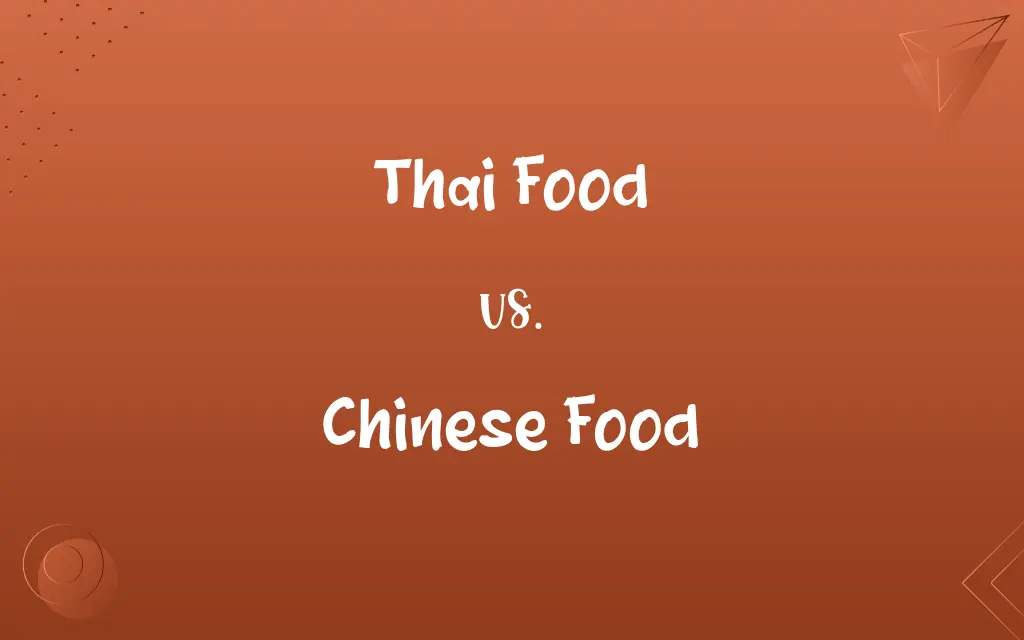Thai Food vs. Chinese Food: Know the Difference

By Shumaila Saeed & Dua Fatima || Published on September 3, 2024
Thai food emphasizes fresh herbs and bold flavors, with a balance of sweet, sour, bitter, and salty. Chinese food offers a diverse range of flavors and techniques, focusing on umami and regional diversity.

Key Differences
Thai and Chinese cuisines are celebrated globally for their distinct flavors and cooking techniques. Thai food is known for its emphatic use of fresh herbs and spices, creating a complex balance of sweet, sour, bitter, and salty tastes. Dishes often include ingredients like lemongrass, kaffir lime leaves, and fish sauce. In contrast, Chinese cuisine offers a broad spectrum of flavors, heavily influenced by the country's diverse regions. It emphasizes umami, achieved through the use of soy sauce, fermented bean paste, and oyster sauce.
Dua Fatima
Sep 03, 2024
One of the hallmarks of Thai cuisine is its emphasis on fresh ingredients and a spicy edge, with dishes like Tom Yum Goong and Som Tam. Chinese food, while also incorporating fresh ingredients, often features stir-frying, steaming, and braising, with a preference for a more subtle spiciness compared to Thai food. Popular Chinese dishes include Peking duck and Mapo tofu, showcasing the cuisine's versatility.
Shumaila Saeed
Sep 03, 2024
Thai meals typically strive for a harmonious finish within a single dish, balancing various flavors and textures. Conversely, Chinese cuisine focuses on creating a balanced meal across several dishes, combining different flavors, textures, and cooking methods to achieve harmony on the table. This approach reflects in the communal style of dining in Chinese culture, where dishes are shared.
Shumaila Saeed
Sep 03, 2024
Another distinguishing feature is the use of rice and noodles. Thai cuisine frequently uses jasmine rice and rice noodles, complementing the intense flavors of its dishes. Chinese cuisine, depending on the region, makes extensive use of both rice (such as in the south) and wheat-based noodles and breads (more common in the north), showcasing the geographic diversity of its food.
Shumaila Saeed
Sep 03, 2024
Both cuisines value the concept of balance and harmony, whether it's in a single dish or across an entire meal, reflecting their rich cultural heritages and the importance of food in social and familial bonds.
Dua Fatima
Sep 03, 2024
ADVERTISEMENT
Comparison Chart
Flavor Profile
Sweet, sour, bitter, and salty with fresh herbs.
Diverse, focusing on umami and regional tastes.
Dua Fatima
Sep 03, 2024
Key Ingredients
Lemongrass, kaffir lime, fish sauce.
Soy sauce, fermented bean paste, oyster sauce.
Shumaila Saeed
Sep 03, 2024
Spiciness
Generally spicy with a bold edge.
Varied; often milder and subtly spiced.
Dua Fatima
Sep 03, 2024
Cooking Techniques
Grilling, pounding, raw preparations.
Stir-frying, steaming, braising.
Shumaila Saeed
Sep 03, 2024
Dining Style
Individual dishes balanced within themselves.
Communal dining with harmony across dishes.
Dua Fatima
Sep 03, 2024
ADVERTISEMENT
Staple Grains
Jasmine rice, rice noodles.
Rice in the south, wheat noodles/breads in the north.
Shumaila Saeed
Sep 03, 2024
Use of Fresh Ingredients
Emphasizes freshness and raw ingredients.
Fresh ingredients with a focus on cooking techniques.
Shumaila Saeed
Sep 03, 2024
Thai Food and Chinese Food Definitions
Thai Food
Rice and noodles serve as the foundation for many meals.
Red curry with rice is a comforting, balanced meal.
Dua Fatima
Feb 28, 2024
Chinese Food
Umami flavors are achieved through sauces and ferments.
Shiitake mushrooms add depth to vegetable stir-fries.
Shumaila Saeed
Feb 28, 2024
ADVERTISEMENT
Thai Food
Known for its vibrant balance of flavors, using ingredients like lemongrass and fish sauce.
Pad Thai combines sweet, sour, and salty with a nutty crunch.
Dua Fatima
Feb 28, 2024
Chinese Food
Techniques like stir-frying and steaming are prevalent.
Stir-fried beef with broccoli is a quick and savory dish.
Dua Fatima
Feb 28, 2024
Thai Food
Spicy dishes are a staple, often highlighted with chili peppers.
Green curry offers a spicy and coconut milk-infused experience.
Shumaila Saeed
Feb 28, 2024
Chinese Food
Dumplings and buns are popular, reflecting the variety in wheat-based dishes.
Steamed pork buns are a soft, flavorful snack.
Hifza Nasir
Feb 28, 2024
Thai Food
Fresh herbs are central, adding unique flavors.
Thai basil chicken bursts with the aroma of basil.
Shumaila Saeed
Feb 28, 2024
Chinese Food
Offers a wide range of flavors, emphasizing regional cuisines.
Cantonese dim sum offers an array of tastes and textures.
Shumaila Saeed
Feb 28, 2024
Thai Food
Street food culture is prominent, offering a variety of dishes.
Mango sticky rice is a popular sweet treat.
Shumaila Saeed
Feb 28, 2024
Chinese Food
Communal dining is customary, with dishes shared at the table.
A family-style meal might include several dishes like roasted duck, stir-fried vegetables, and rice.
Dua Fatima
Feb 28, 2024
Repeatedly Asked Queries
Can Thai food be less spicy?
Yes, Thai food can be adjusted for spice levels, though traditionally it is known for its bold spiciness.
Shumaila Saeed
Sep 03, 2024
What are some must-try Chinese dishes?
Must-try Chinese dishes include Peking duck, dumplings, and Sichuan spicy tofu.
Dua Fatima
Sep 03, 2024
How does Chinese food achieve its diverse flavor profile?
Chinese food's diversity comes from its regional variations and the use of different cooking techniques, ingredients, and umami-rich condiments.
Shumaila Saeed
Sep 03, 2024
How do Thai and Chinese cuisines differ in their use of noodles?
Thai cuisine commonly uses rice noodles, while Chinese cuisine employs a variety of noodles, including wheat-based options.
Shumaila Saeed
Sep 03, 2024
What role do fresh ingredients play in Thai food?
Fresh ingredients are crucial in Thai food for adding flavor, aroma, and texture, often used in raw or lightly cooked forms.
Dua Fatima
Sep 03, 2024
Can I find gluten-free options in Thai and Chinese cuisines?
Gluten-free options are available, but it's important to be mindful of sauces and cross-contamination in both cuisines.
Shumaila Saeed
Sep 03, 2024
Is rice important in both Thai and Chinese cuisines?
Yes, rice is a staple in both cuisines, with jasmine rice prevalent in Thai dishes and both white rice and various types of noodles common in Chinese cuisine.
Shumaila Saeed
Sep 03, 2024
What makes Thai food unique?
Thai food's uniqueness lies in its balance of sweet, sour, bitter, and salty flavors, using an array of fresh herbs and spices.
Dua Fatima
Sep 03, 2024
What makes a dish authentically Thai or Chinese?
Authenticity comes from traditional ingredients, cooking methods, and cultural context specific to each cuisine.
Hifza Nasir
Sep 03, 2024
Are there vegetarian options in Thai and Chinese food?
Both cuisines offer vegetarian options, though they may use different ingredients to achieve their signature flavors.
Dua Fatima
Sep 03, 2024
How does the concept of balance manifest in Chinese cuisine?
In Chinese cuisine, balance is achieved across different dishes in a meal, combining various flavors, textures, and cooking methods.
Shumaila Saeed
Sep 03, 2024
How do Thai and Chinese cuisines approach cooking meat?
Thai cuisine often grills or pounds meat, while Chinese cuisine prefers stir-frying, steaming, or braising for tenderness and flavor.
Dua Fatima
Sep 03, 2024
Why is street food popular in Thai cuisine?
Street food is popular for its accessibility, variety, and the way it showcases the vibrant flavors and ingredients of Thai cuisine.
Shumaila Saeed
Sep 03, 2024
Share this page
Link for your blog / website
HTML
Link to share via messenger
About Author
Written by
Shumaila SaeedShumaila Saeed, an expert content creator with 6 years of experience, specializes in distilling complex topics into easily digestible comparisons, shining a light on the nuances that both inform and educate readers with clarity and accuracy.
Co-written by
Dua Fatima








































































